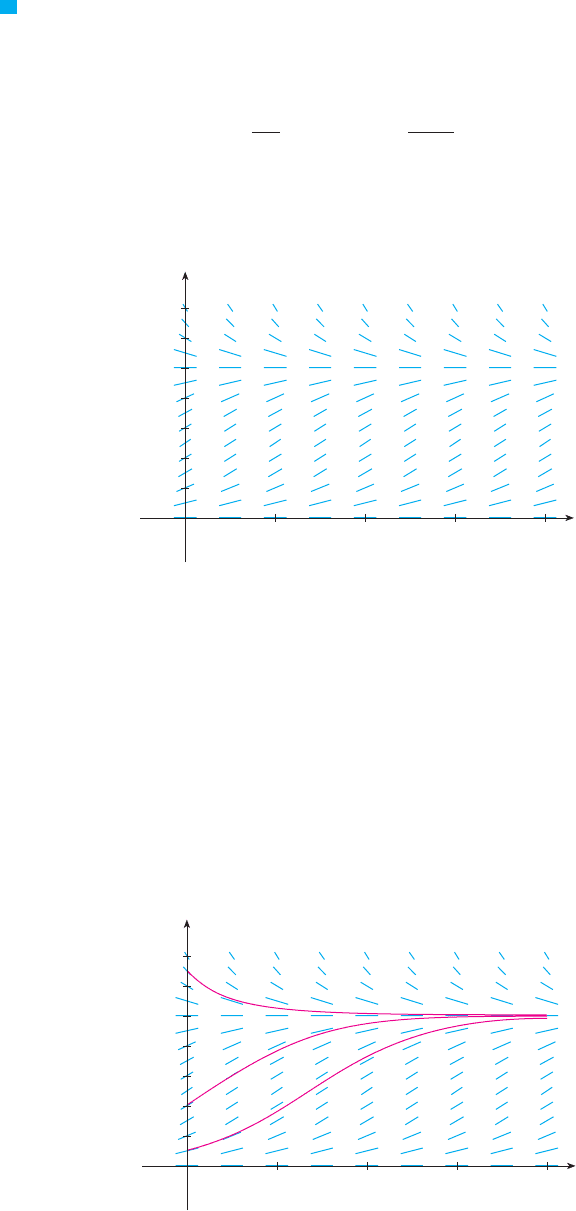Stewart J. Calculus
Подождите немного. Документ загружается.


622
|| ||
CHAPTER 10 DIFFERENTIAL EQUATIONS
;
24. Solve the equation and graph several
members of the family of solutions. How does the solution
curve change as the constant varies?
Solve the initial-value problem ,
, and graph the solution (if your CAS does
implicit plots).
26. Solve the equation and graph several
members of the family of solutions (if your CAS does
implicit plots). How does the solution curve change as the
constant varies?
27–28
(a) Use a computer algebra system to draw a direction field
for the differential equation. Get a printout and use it to
sketch some solution curves without solving the differential
equation.
(b) Solve the differential equation.
(c) Use the CAS to draw several members of the family of solu-
tions obtained in part (b). Compare with the curves from
part (a).
27. 28.
;
29–32 Find the orthogonal trajectories of the family of curves.
Use a graphing device to draw several members of each family on
a common screen.
29. 30.
32.
33. Solve the initial-value problem in Exercise 27 in Section 10.2
to find an expression for the charge at time . Find the limit-
ing value of the charge.
34. In Exercise 28 in Section 10.2 we discussed a differential
equation that models the temperature of a cup of coffee
in a room. Solve the differential equation to find an
expression for the temperature of the coffee at time .
In Exercise 13 in Section 10.1 we formulated a model for
learning in the form of the differential equation
where measures the performance of someone learning a
skill after a training time , is the maximum level of per-
formance, and is a positive constant. Solve this differential
equation to find an expression for . What is the limit of
this expression?
P!t"
k
Mt
P!t"
dP
dt
! k!M ! P"
35.
t
20"C
95"C
t
y !
x
1 # kx
y !
k
x
31.
y
2
! kx
3
x
2
# 2y
2
! k
2
y$ ! x
2
#yy$ ! 1#y
CAS
C
y$ ! x
s
x
2
# 1#!ye
y
"
CAS
y!0" !
%
#2
y$ ! !sin x"#sin y
25.
CAS
C
e
!y
y$ # cos x ! 0
1–10 Solve the differential equation.
1. 2.
3. 4.
5. 6.
7. 8.
9.
11–18 Find the solution of the differential equation that satisfies
the given initial condition.
11. ,
12. ,
13. ,
14. ,
,
16. ,
17. , ,
18. ,
19. Find an equation of the curve that passes through the point
and whose slope at is .
20. Find the function such that and
.
21. Solve the differential equation by making the
change of variable .
22. Solve the differential equation by making the
change of variable .
23. (a) Solve the differential equation .
;
(b) Solve the initial-value problem ,
, and graph the solution.
(c) Does the initial-value problem ,
, have a solution? Explain.y!0" ! 2
y$ ! 2x
s
1 ! y
2
y!0" ! 0
y$ ! 2x
s
1 ! y
2
y$ ! 2x
s
1 ! y
2
v ! y#x
xy$ ! y # xe
y#x
u ! x # y
y$ ! x # y
f !0" !
1
2
f $!x" ! f !x"!1 ! f !x""f
xy!x, y"!0, 1"
L!1" ! !1
dL
dt
! kL
2
ln t
0
&
x
&
%
#2y!
%
#3" ! ay$ tan x ! a # y
y!1" ! !1x y$ # y ! y
2
u!0" ! !5
du
dt
!
2t # sec
2
t
2u
15.
P!1" ! 2
dP
dt
!
s
Pt
y!0" ! 0x cos x ! !2y # e
3y
"y$
y!0" ! 1
dy
dx
!
y cos x
1 # y
2
y!0" ! !3
dy
dx
!
x
y
dz
dt
# e
t#z
! 0
10.
du
dt
! 2 # 2u # t # tu
dy
d
'
!
e
y
sin
2
'
y sec
'
dy
dt
!
te
t
y
s
1 # y
2
du
dr
!
1 #
s
r
1 #
s
u
!1 # tan y"y$ ! x
2
# 1
y$ ! y
2
sin x!x
2
# 1"y$ ! xy
dy
dx
!
s
x
e
y
dy
dx
!
y
x
E X E R C I S E S
10.3

(a) Suppose that the concentration at time is . Deter-
mine the concentration at any time by solving the differ-
ential equation.
(b) Assuming that , find and interpret
your answer.
40. A certain small country has $10 billion in paper currency
in circulation, and each day $50 million comes into the
country’s banks. The government decides to introduce new
currency by having the banks replace old bills with new ones
whenever old currency comes into the banks. Let
denote the amount of new currency in circulation at time ,
with .
(a) Formulate a mathematical model in the form of an
initial-value problem that represents the “flow” of the
new currency into circulation.
(b) Solve the initial-value problem found in part (a).
(c) How long will it take for the new bills to account for
of the currency in circulation?
41. A tank contains 1000 L of brine with 15 kg of dissolved salt.
Pure water enters the tank at a rate of 10 L#min. The solution
is kept thoroughly mixed and drains from the tank at the same
rate. How much salt is in the tank (a) after minutes and
(b) after 20 minutes?
42. The air in a room with volume contains carbon
dioxide initially. Fresher air with only 0.05% carbon dioxide
flows into the room at a rate of and the mixed air
flows out at the same rate. Find the percentage of carbon
dioxide in the room as a function of time. What happens in
the long run?
43. A vat with 500 gallons of beer contains 4% alcohol (by
volume). Beer with 6% alcohol is pumped into the vat at a
rate of and the mixture is pumped out at the same
rate. What is the percentage of alcohol after an hour?
44. A tank contains 1000 L of pure water. Brine that contains
0.05 kg of salt per liter of water enters the tank at a rate of
5 L#min. Brine that contains 0.04 kg of salt per liter of water
enters the tank at a rate of 10 L#min. The solution is kept
thoroughly mixed and drains from the tank at a rate of
15 L#min. How much salt is in the tank (a) after minutes
and (b) after one hour?
When a raindrop falls, it increases in size and so its mass at
time is a function of , . The rate of growth of the mass
is for some positive constant . When we apply New-
ton’s Law of Motion to the raindrop, we get ,
where is the velocity of the raindrop (directed downward)
and is the acceleration due to gravity. The terminal velocity
of the raindrop is . Find an expression for the ter-
minal velocity in terms of and .
46. An object of mass is moving horizontally through a
medium which resists the motion with a force that is a func-
tion of the velocity; that is,
m
d
2
s
dt
2
! m
d
v
dt
! f !v"
m
kt
lim
t
l
(
v!t"
t
v
!mv"$ ! tm
kkm!t"
m!t"tt
45.
t
5 gal#min
2 m
3
#min
0.15%180 m
3
t
90%
x!0" ! 0
t
x ! x !t"
lim
t
l
(
C!t"C
0
&
r#k
t
C
0
t ! 0
36. In an elementary chemical reaction, single molecules of
two reactants A and B form a molecule of the product C:
. The law of mass action states that the rate
of reaction is proportional to the product of the concen-
trations of A and B:
(See Example 4 in Section 3.7.) Thus, if the initial concentra-
tions are A moles#L and B moles#L and we
write C , then we have
(a) Assuming that , find as a function of . Use the
fact that the initial concentration of C is 0.
(b) Find assuming that . How does this expres-
sion for simplify if it is known that after
20 seconds?
37. In contrast to the situation of Exercise 36, experiments show
that the reaction satisfies the rate law
and so for this reaction the differential equation becomes
where and and are the initial concentrations of
hydrogen and bromine.
(a) Find as a function of in the case where . Use the
fact that .
(b) If , find as a function of . Hint: In performing
the integration, make the substitution
38. A sphere with radius 1 m has temperature . It lies inside
a concentric sphere with radius 2 m and temperature .
The temperature at a distance from the common center
of the spheres satisfies the differential equation
If we let , then satisfies a first-order differential
equation. Solve it to find an expression for the temperature
between the spheres.
A glucose solution is administered intravenously into the
bloodstream at a constant rate . As the glucose is added, it is
converted into other substances and removed from the blood-
stream at a rate that is proportional to the concentration at
that time. Thus a model for the concentration of the
glucose solution in the bloodstream is
where is a positive constant.k
dC
dt
! r ! kC
C ! C!t"
r
39.
T!r"
SS ! dT#dr
d
2
T
dr
2
#
2
r
dT
dr
! 0
rT !r"
25 "C
15 "C
u !
s
b ! x
.
]
[
xta ) b
x!0" ! 0
a ! btx
bax ! $HBr%
dx
dt
! k!a ! x"!b ! x"
1#2
d$HBr%
dt
! k $H
2
%$Br
2
%
1#2
H
2
# Br
2
l
2HBr
$C% !
1
2
ax!t"
a ! bx !t"
txa " b
CAS
dx
dt
! k!a ! x"!b ! x"
%x ! $
% ! b$% ! a$
d$C%
dt
! k $A%$B%
A # B l C
SECTION 10.3 SEPARABLE EQUATIONS
|| ||
623

If water (or other liquid) drains from a tank, we expect that the flow will be greatest at first (when
the water depth is greatest) and will gradually decrease as the water level decreases. But we need
a more precise mathematical description of how the flow decreases in order to answer the kinds
of questions that engineers ask: How long does it take for a tank to drain completely? How much
water should a tank hold in order to guarantee a certain minimum water pressure for a sprinkler
system?
Let and be the height and volume of water in a tank at time . If water drains through a
hole with area at the bottom of the tank, then Torricelli’s Law says that
where is the acceleration due to gravity. So the rate at which water flows from the tank is propor-
tional to the square root of the water height.
1. (a) Suppose the tank is cylindrical with height 6 ft and radius 2 ft and the hole is circular with
radius 1 inch. If we take ft#s , show that satisfies the differential equation
(b) Solve this equation to find the height of the water at time , assuming the tank is full at
time .
(c) How long will it take for the water to drain completely?
t ! 0
t
dh
dt
! !
1
72
s
h
h
2
t ! 32
t
dV
dt
! !a
s
2th
1
a
tV!t"h!t"
HOW FAST DOES A TANK DRAIN?
A P P L I E D
P R O J E C T
48. According to Newton’s Law of Universal Gravitation, the
gravitational force on an object of mass that has been pro-
jected vertically upward from the earth’s surface is
where is the object’s distance above the surface
at time , is the earth’s radius, and is the acceleration
due to gravity. Also, by Newton’s Second Law,
and so
(a) Suppose a rocket is fired vertically upward with an initial
velocity . Let be the maximum height above the sur-
face reached by the object. Show that
[Hint: By the Chain Rule, .]
(b) Calculate . This limit is called the escape
velocity for the earth.
(c) Use mi and ft#s to calculate in
feet per second and in miles per second.
v
e
2
t ! 32R ! 3960
v
e
! lim
h
l
(
v
0
m !dv#dt" ! mv !dv#dx"
v
0
!
&
2tRh
R # h
hv
0
m
dv
dt
! !
mtR
2
!x # R"
2
F ! ma ! m !dv#dt"
tRt
x ! x!t"
F !
mtR
2
!x # R"
2
m
where and represent the velocity and
position of the object at time , respectively. For example,
think of a boat moving through the water.
(a) Suppose that the resisting force is proportional to the
velocity, that is, , a positive constant.
(This model is appropriate for small values of .) Let
and be the initial values of and .
Determine and at any time . What is the total distance
that the object travels from time ?
(b) For larger values of a better model is obtained by sup-
posing that the resisting force is proportional to the square
of the velocity, that is, , . (This model
was first proposed by Newton.) Let and be the initial
values of and . Determine and at any time . What is
the total distance that the object travels in this case?
47. Let be the area of a tissue culture at time and let be
the final area of the tissue when growth is complete. Most
cell divisions occur on the periphery of the tissue and the
number of cells on the periphery is proportional to . So
a reasonable model for the growth of tissue is obtained by
assuming that the rate of growth of the area is jointly propor-
tional to and .
(a) Formulate a differential equation and use it to show that
the tissue grows fastest when .
(b) Solve the differential equation to find an expression
for . Use a computer algebra system to perform the
integration.
A!t"
CAS
A!t" !
1
3
M
M ! A!t"
s
A!t"
s
A!t"
MtA!t"
tsvsv
s
0
v
0
k ) 0f !v" ! !kv
2
v
t ! 0
ts
v
svs!0" ! s
0
v!0" ! v
0
v
kf !v" ! !kv
t
s ! s!t"
v ! v!t"
624
|| ||
CHAPTER 10 DIFFERENTIAL EQUATIONS

2. Because of the rotation and viscosity of the liquid, the theoretical model given by Equation 1
isn’t quite accurate. Instead, the model
is often used and the constant (which depends on the physical properties of the liquid) is
determined from data concerning the draining of the tank.
(a) Suppose that a hole is drilled in the side of a cylindrical bottle and the height of the
water (above the hole) decreases from 10 cm to 3 cm in 68 seconds. Use Equation 2 to
find an expression for . Evaluate for .
(b) Drill a 4-mm hole near the bottom of the cylindrical part of a two-liter plastic soft-drink
bottle. Attach a strip of masking tape marked in centimeters from 0 to 10, with 0 corre-
sponding to the top of the hole. With one finger over the hole, fill the bottle with water
to the 10-cm mark. Then take your finger off the hole and record the values of for
seconds. (You will probably find that it takes 68 seconds for the
level to decrease to .) Compare your data with the values of from part (a).
How well did the model predict the actual values?
3. In many parts of the world, the water for sprinkler systems in large hotels and hospitals is
supplied by gravity from cylindrical tanks on or near the roofs of the buildings. Suppose
such a tank has radius 10 ft and the diameter of the outlet is 2.5 inches. An engineer has to
guarantee that the water pressure will be at least 2160 for a period of 10 minutes. (When
a fire happens, the electrical system might fail and it could take up to 10 minutes for the emer-
gency generator and fire pump to be activated.) What height should the engineer specify for
the tank in order to make such a guarantee? (Use the fact that the water pressure at a depth of
feet is . See Section 9.3.)
4. Not all water tanks are shaped like cylinders. Suppose a tank has cross-sectional area at
height . Then the volume of water up to height is and so the Fundamental
Theorem of Calculus gives . It follows that
and so Torricelli’s Law becomes
(a) Suppose the tank has the shape of a sphere with radius 2 m and is initially half full of
water. If the radius of the circular hole is 1 cm and we take m#s , show that
satisfies the differential equation
(b) How long will it take for the water to drain completely?
!4h ! h
2
"
dh
dt
! !0.0001
s
20h
h
2
t ! 10
A!h"
dh
dt
! !a
s
2th
dV
dt
!
dV
dh
dh
dt
! A!h"
dh
dt
dV#dh ! A!h"
V !
x
h
0
A!u" duhh
A!h"
P ! 62.5dd
lb#ft
2
h!t"h ! 3 cm
t ! 10, 20, 30, 40, 50, 60
h!t"
t ! 10, 20, 30, 40, 50, 60h!t"h!t"
h
k
dh
dt
! k
s
h
2
APPLIED PROJECT HOW FAST DOES A TANK DRAIN?
|| ||
625
N This part of the project is best done as a
classroom demonstration or as a group project
with three students in each group: a time-
keeper to call out seconds, a bottle keeper to
estimate the height every 10 seconds, and a
record keeper to record these values.

Suppose you throw a ball into the air. Do you think it takes longer to reach its maximum
height or to fall back to earth from its maximum height? We will solve the problem in this proj-
ect but, before getting started, think about that situation and make a guess based on your physical
intuition.
1.
A ball with mass is projected vertically upward from the earth’s surface with a positive
initial velocity . We assume the forces acting on the ball are the force of gravity and a
retarding force of air resistance with direction opposite to the direction of motion and with
magnitude , where is a positive constant and is the velocity of the ball at time .
In both the ascent and the descent, the total force acting on the ball is . [During
ascent, is positive and the resistance acts downward; during descent, is negative and
the resistance acts upward.] So, by Newton’s Second Law, the equation of motion is
Solve this differential equation to show that the velocity is
2. Show that the height of the ball, until it hits the ground, is
3.
Let be the time that the ball takes to reach its maximum height. Show that
Find this time for a ball with mass 1 kg and initial velocity 20 m#s. Assume the air
resistance is of the speed.
;
4. Let be the time at which the ball falls back to earth. For the particular ball in Problem 3,
estimate by using a graph of the height function . Which is faster, going up or coming
down?
5.
In general, it’s not easy to find because it’s impossible to solve the equation
explicitly. We can, however, use an indirect method to determine whether ascent or descent
is faster; we determine whether is positive or negative. Show that
where . Then show that and the function
is increasing for . Use this result to decide whether is positive or negative.
What can you conclude? Is ascent or descent faster?
y!2t
1
"x ) 1
f !x" ! x !
1
x
! 2 ln x
x ) 1x ! e
pt
1
#m
y!2t
1
" !
m
2
t
p
2
'
x !
1
x
! 2 ln x
(
y!2t
1
"
y!t" ! 0t
2
y!t"t
2
t
2
1
10
t
1
!
m
p
ln
'
mt # p
v
0
mt
(
t
1
y!t" !
'
v
0
#
mt
p
(
m
p
!1 ! e
!pt#m
" !
mtt
p
v
!t" !
'
v
0
#
mt
p
(
e
!pt#m
!
mt
p
m
v
$ ! !p
v
! mt
v
!t"
v
!t"
!p
v
! mt
t
v
!t"pp
)
v
!t"
)
v
0
m
WHICH IS FASTER, GOING UP OR COMING DOWN?
A P P L I E D
P R O J E C T
626
|| ||
CHAPTER 10 DIFFERENTIAL EQUATIONS
N
In modeling force due to air resistance,
various functions have been used, depending
on the physical characteristics and speed of
the ball. Here we use a linear model, , but
a quadratic model ( on the way up and
on the way down) is another possibility for
higher speeds (see Exercise 46 in Section 10.3).
For a golf ball, experiments have shown that a
good model is going up and
coming down. But no matter which force func-
tion is used [where for
and for ], the answer to the
question remains the same. See F. Brauer,
“What Goes Up Must Come Down, Eventually,”
Amer. Math. Monthly
108 (2001), pp. 437–440.
v
&
0f !
v
"
&
0
v
) 0f !
v
" ) 0!f !
v
"
p
)
v
)
1.3
!p
v
1.3
p
v
2
!p
v
2
!pv
Openmirrors.com

MODELS FOR POPULATION GROWTH
In this section we investigate differential equations that are used to model population
growth: the law of natural growth, the logistic equation, and several others.
THE LAW OF NATURAL GROWTH
One of the models for population growth that we considered in Section 10.1 was based
on the assumption that the population grows at a rate proportional to the size of the
population:
Is that a reasonable assumption? Suppose we have a population (of bacteria, for instance)
with size and at a certain time it is growing at a rate of bacteria per
hour. Now let’s take another 1000 bacteria of the same type and put them with the first pop-
ulation. Each half of the new population was growing at a rate of 300 bacteria per hour.
We would expect the total population of 2000 to increase at a rate of 600 bacteria per
hour initially (provided there’s enough room and nutrition). So if we double the size, we
double the growth rate. In general, it seems reasonable that the growth rate should be pro-
portional to the size.
In general, if is the value of a quantity at time and if the rate of change of
with respect to is proportional to its size at any time, then
where is a constant. Equation 1 is sometimes called the law of natural growth. If is pos-
itive, then the population increases; if is negative, it decreases.
Because Equation 1 is a separable differential equation, we can solve it by the methods
of Section 10.3:
where A ( or 0) is an arbitrary constant. To see the significance of the constant A,
we observe that
Therefore A is the initial value of the function.
The solution of the initial-value problem
is
P!t" ! P
0
e
kt
P!0" ! P
0
dP
dt
! kP
2
P!0" ! Ae
k ! 0
! A
! *e
C
P ! Ae
kt
)
P
)
! e
kt#C
! e
C
e
kt
ln
)
P
)
! kt # C
y
dP
P
!
y
k dt
k
kk
dP
dt
! kP
1
P!t"t
PtyP!t"
P$ ! 300P ! 1000
dP
dt
! kP
10.4
SECTION 10.4 MODELS FOR POPULATION GROWTH
|| ||
627
N Examples and exercises on the use of (2) are
given in Section 7.5.

Another way of writing Equation 1 is
which says that the relative growth rate (the growth rate divided by the population size)
is constant. Then (2) says that a population with constant relative growth rate must grow
exponentially.
We can account for emigration (or “harvesting”) from a population by modifying Equa-
tion 1: If the rate of emigration is a constant , then the rate of change of the population
is modeled by the differential equation
See Exercise 13 for the solution and consequences of Equation 3.
THE LOGISTIC MODEL
As we discussed in Section 10.1, a population often increases exponentially in its early
stages but levels off eventually and approaches its carrying capacity because of limited
resources. If is the size of the population at time t, we assume that
This says that the growth rate is initially close to being proportional to size. In other words,
the relative growth rate is almost constant when the population is small. But we also want
to reflect the fact that the relative growth rate decreases as the population P increases and
becomes negative if P ever exceeds its carrying capacity K, the maximum population that
the environment is capable of sustaining in the long run. The simplest expression for the
relative growth rate that incorporates these assumptions is
Multiplying by P, we obtain the model for population growth known as the logistic differ-
ential equation:
Notice from Equation 4 that if P is small compared with K, then is close to 0 and so
. However, if (the population approaches its carrying capacity), then
, so . We can deduce information about whether solutions increase or
decrease directly from Equation 4. If the population P lies between 0 and K, then the right
side of the equation is positive, so and the population increases. But if the pop-
ulation exceeds the carrying capacity , then is negative, so
and the population decreases.
Let’s start our more detailed analysis of the logistic differential equation by looking at
a direction field.
dP#dt
&
01 ! P#K!P ) K"
dP#dt ) 0
dP#dt l 0P#K l 1
P l KdP#dt * kP
P#K
dP
dt
! kP
'
1 !
P
K
(
4
1
P
dP
dt
! k
'
1 !
P
K
(
if P is small
dP
dt
* kP
P!t"
dP
dt
! kP ! m
3
m
1
P
dP
dt
! k
628
|| ||
CHAPTER 10 DIFFERENTIAL EQUATIONS

EXAMPLE 1 Draw a direction field for the logistic equation with and carry-
ing capacity . What can you deduce about the solutions?
SOLUTION In this case the logistic differential equation is
A direction field for this equation is shown in Figure 1. We show only the first quadrant
because negative populations aren’t meaningful and we are interested only in what hap-
pens after .
The logistic equation is autonomous ( depends only on P, not on t), so the
slopes are the same along any horizontal line. As expected, the slopes are positive for
and negative for .
The slopes are small when P is close to 0 or 1000 (the carrying capacity). Notice that
the solutions move away from the equilibrium solution and move toward the
equilibrium solution .
In Figure 2 we use the direction field to sketch solution curves with initial populations
, , and . Notice that solution curves that start below
are increasing and those that start above are decreasing. The slopes
are greatest when and therefore the solution curves that start below
have inflection points when . In fact we can prove that all solution curves that
start below have an inflection point when P is exactly 500. (See Exercise 9.)
M
0 t
P
80
1400
604020
1200
1000
800
600
400
200
F I G U R E 2
Solution curves for the logistic
equation in Example 1
P ! 500
P * 500
P ! 1000P * 500
P ! 1000P ! 1000
P!0" ! 1300P!0" ! 400P!0" ! 100
P ! 1000
P ! 0
P ) 10000
&
P
&
1000
dP#dt
0 t
P
80
1400
604020
1200
1000
800
600
400
200
F I G U R E 1
Direction field for the logistic
equation in Example 1
t ! 0
dP
dt
! 0.08P
'
1 !
P
1000
(
K ! 1000
k ! 0.08
V
SECTION 10.4 MODELS FOR POPULATION GROWTH
|| ||
629

The logistic equation (4) is separable and so we can solve it explicitly using the method
of Section 10.3. Since
we have
To evaluate the integral on the left side, we write
Using partial fractions (see Section 8.4), we get
This enables us to rewrite Equation 5:
where . Solving Equation 6 for P, we get
so
We find the value of A by putting in Equation 6. If , then (the initial
population), so
K ! P
0
P
0
! Ae
0
! A
P ! P
0
t ! 0t ! 0
P !
K
1 # Ae
!kt
P
K
!
1
1 # Ae
!kt
?
K
P
! 1 ! Ae
!kt
A ! *e
!C
K ! P
P
! Ae
!kt
6
+
K ! P
P
+
! e
!kt!C
! e
!C
e
!kt
ln
+
K ! P
P
+
! !kt ! C
ln
)
P
)
! ln
)
K ! P
)
! kt # C
y
'
1
P
#
1
K ! P
(
dP !
y
k dt
K
P!K ! P"
!
1
P
#
1
K ! P
1
P!1 ! P#K"
!
K
P!K ! P"
y
dP
P!1 ! P#K"
!
y
k dt
5
dP
dt
! kP
'
1 !
P
K
(
630
|| ||
CHAPTER 10 DIFFERENTIAL EQUATIONS

Thus the solution to the logistic equation is
Using the expression for in Equation 7, we see that
which is to be expected.
EXAMPLE 2 Write the solution of the initial-value problem
and use it to find the population sizes and . At what time does the population
reach 900?
SOLUTION The differential equation is a logistic equation with , carrying capac-
ity , and initial population . So Equation 7 gives the population at
time t as
Thus
So the population sizes when and 80 are
The population reaches 900 when
Solving this equation for t, we get
So the population reaches 900 when t is approximately 55. As a check on our work, we
graph the population curve in Figure 3 and observe where it intersects the line .
The cursor indicates that .
M
t * 55
P ! 900
t !
ln 81
0.08
* 54.9
!0.08t ! ln
1
81
! !ln 81
e
!0.08t
!
1
81
1 # 9e
!0.08t
!
10
9
1000
1 # 9e
!0.08t
! 900
P!80" !
1000
1 # 9e
!6.4
* 985.3P!40" !
1000
1 # 9e
!3.2
* 731.6
t ! 40
P!t" !
1000
1 # 9e
!0.08t
where A !
1000 ! 100
100
! 9P!t" !
1000
1 # Ae
!0.08t
P
0
! 100K ! 1000
k ! 0.08
P!80"P!40"
P!0" ! 100
dP
dt
! 0.08P
'
1 !
P
1000
(
lim
t l (
P!t" ! K
P!t"
where A !
K ! P
0
P
0
P!t" !
K
1 # Ae
!kt
7
SECTION 10.4 MODELS FOR POPULATION GROWTH
|| ||
631
N Compare the solution curve in Figure 3 with
the lowest solution curve we drew from the
direction field in Figure 2.
1000
0 80
P=
1000
1+9e
_0.08t
P=900
F I G U R E 3
